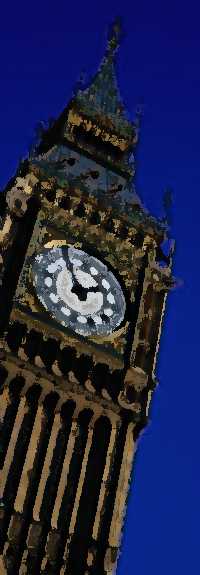|
We tend to think that
the Elizabethan age strictly refers to the reign of Queen Elizabeth. However, the beginning of this period officially started
in 1485 with the end of the Wars of the Roses, and Queen Elizabeth only came to the throne in 1558.
This age had considerable
influences and to understand how it was created, it is especially significant to understand the Renaissance. Many relevant
things which influenced the Renaissance occurred almost simultaneously. To begin with, the capture of Constantinople, in 1453,
which made several Greek scholars take refuge in Italy, and as a consequence, there was the revival of classical learning:
everything that was human began to be particularly important. Reason, rather than religion, became the guidance to rule human
behavior in this age and the intellectuals of this period were called the Humanists. Then, with the invention of printing,
the production of books increased as well as their spread. Afterwards, there was the development of commerce, leading to easier
and more thriving trade, creating a new wealthy class: that of the merchants. Finally, there were the great voyages of discovery.
In 1492, the voyage to the Americas opened European eyes to the existence of the New World.
When the Wars of the Roses
ended in 1485, a new English dynasty assumed power: the Tudors. Henry VII was the first to take power, followed by Henry VIII.
Continuing with this power was so important to the Tudors, that even having been married six times, Henry VIII wanted to marry
again so that he could try to have a son to succeed him. Needless to say that divorce was not allowed at that time, which
is why Henry VIII came into open conflict with the Catholic Church. In summary, Henry VIII ended the rule of the Catholic
Church in England. At this time, monks did not help the community as they were meant to do, for they seemed to take money
from the poor; also, some monasteries were huge and owned vast areas of land, so Henry decided to shut down the monasteries
of England. This movement was called the Reformation, which made dramatic changes in the way of thinking. England became Protestant
and English identity as a nation had to be redefined religiously and politically. Due to the Reformation, England’s
identity began to be distinct from Europe.
The Reign of Queen Elizabeth (1558 - 1603)

Elizabeth I, the last
Tudor monarch, was born in Greenwich on September 7, 1533, the daughter of Henry VIII and his second wife, Anne Boleyn.
Elizabeth succeeded to the throne on her half sister’s death, Mary, in November 1558. She was a brilliant, well-educated
and talented woman, fluent in six languages, whose 45-year reign is considered one of the most glorious in English History.
She was very careful with public money and also very diplomatic; she knew how to deal with the Parliament, respecting their
privileges and, as a result, assuring their loyalty. By pursuing moderate religious policies, she prevented the danger of
open conflict between Protestants and Catholics. “Gloriana”, as she was called by Edmund Spenser, reduced taxes,
broadened education and arts. She promoted sea power and colonial expansion, by stimulating commerce and exploration.
The Flowering of Elizabethan Literature
Queen Elizabeth’s
reign gave England some sense of stability and a considerable sense of national and religious triumph after the defeat of
the Spanish Armada in 1588. All the energy and confidence born in this period found expression in literature.
Up to that time, England
had been far behind Italy, Spain and France in literature and the arts. The English poets could only follow foreign models.
The most important one was the Italian sonnet form, which was changed later by Shakespeare.
After ten years of the
defeat of the Spanish Armada, William Shakespeare was already writing brilliantly and was already using a rich and varied
vocabulary. There was a rapid growth in the number of foreign words which became part of the English language. New words came
from over fifty other languages, including the languages of Africa, Asia, and North America.
Others aspects of the
expansion of language were: new formations of words by adding prefixes and suffixes, and by creating new compounds; and also,
word-class conversion, which is the change of one class of words into another. This was a common feature of Shakespeare’s
English.
Poetry, both lyrical and
dramatic, became the pastime of educated people, but drama was the dominant form of the age. The plays of William Shakespeare
and Christopher Marlowe were popular with all levels of society. Other writers of the period include Edmund Spenser, Sir Walter
Raleigh, Ben Jonson and Francis Bacon.
The Development of English Drama

Theater in England began
in the church: the necessity to convert people to Christianity led the church to perform plays (in English) based on the Bible.
These plays were performed inside the church by the clergy themselves and the primary objective was to attract every person
into attending the church by teaching Bible passages, incidents described in the Bible – usually miracles. Therefore,
these plays are known as “the miracle plays”.
As the theater evolved,
the morality plays emerged. These plays were based on Biblical passages as well. However, they were not faithful to the Bible,
since they did not intend to preach Christianity. The purpose was to teach manners and moral lessons. These plays were performed
in the streets by members of guilds in carriages.
Then, there were the interludes.
These were plays with the only objective of entertaining the nobles. They were characterized by being short, presenting only
one act; there were no religious influences and no moral lessons.

Regarding its structure,
Elizabethan theater was open-air, usually round, with an open area in front of the stage, called the pit. Doors were placed
on each side of the stage as entry and exit points for actors and there was a high balcony used for scenes where characters
were required to relate to others below. The buildings had an elevated area in front of the stage that was reserved for nobles,
and some important people could even watch the plays from the stage itself.
So far, the drama presented
its rules of unity, inherited from the Greek plays: time, space and action. The Elizabethan drama ruptured with these rules.
The plays were now allowed to tell a story that happens in over 24 hours, in different places (rooms, cities or countries)
and that has more than one main plot. A great example is Othello, by William Shakespeare, which starts in Venice and ends
in Cyprus. The tragedy lasts several days and concerning action, it presents many plots happening simultaneously.

Othello, The Moor of Venice,
has four main characters: Othello, his wife Desdemona, his lieutenant Cassio, and his ensign Iago. The play is based on human
nature features such as: love, jealousy, revenge, betrayal, and racism. In this stage piece, racism is strongly emphasized
in the passages regarding Othello.
In this part, Othello
is referred as a “black ram” and also as “the Devil” (represented by tradition as black), which shows
that Othello’s complexion is a matter of importance.
Racism is easily identified
in the passage above, when Iago refers to Othello by Barbary horse, also mentioning that Othello would not be qualified enough
to give Brabantio noble grandchildren; he would have coursers, race-horses, and jennets, Moorish ponies, as heirs.
In the previous section,
Iago comments on Othello’s intelligence while he addresses him as an ass, insinuating he is less intellectually capable.
In other passages, Othello
is addressed in a less aggressive way. For instance, when Brabantio discovers the union between his daughter and the General
and calls him a “thing” in a humiliating speech, or even when Iago implies that Othello is not a very stable person
and affirms: “these Moors are changeable in their wills.”
The Elizabethan Prose
The Elizabethan age is
a literary period extremely marked by its poetry and drama. However, some works in prose indeed existed. Since poetry and
drama were more developed than prose in that time, the latter does not have as much recognition as the other two genres.
Despite the need to be
mastered, the Elizabethan prose does present some works as good results: the essays by Francis Bacon (1561-1626), the narratives
of Sir Walter Raleigh (1552-1618), the prose narratives (which was influenced by the emergence of the bourgeois class), and
the most important contribution to the Elizabethan prose: the translation of the Bible into English by King James I, known
as the King James’ Bible.
Although there are some
prose masterpieces in that period, the prose styles only came easily to authors in the following age.
Edmund Spenser (1552 - 1599)
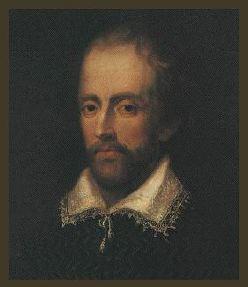
Called the poet’s
poet for his impressive control of the poet’s craft and creative imagination, Edmund Spenser was an important English
poet and a Poet Laureate. He attended school on a scholarship set up for poor boys called Merchant Taylors’ School and
later went to Cambridge University.
Soon, after leaving Cambridge, he published The Shepherd’s Calendar, a work that consists of twelve poems (representative
of the twelve months) which describe the beauties of the countryside.
He gained recognition
with this work, but his masterpiece was The Faerie Queene, which he wrote in tribute to Queen Elizabeth, encouraged by Sir
Walter Raleigh. He wrote it in the called Spenserian stanza, a stanza that he created, which consists of eight lines in iambic
pentameter and the ninth line has two extra syllables. Such a line is called an Alexandrine.
Spenser also wrote to
his wife, Elizabeth Boyle, a famous sequence of sonnets called Amoretti.
Cristopher Marlowe (1564 - 1593)
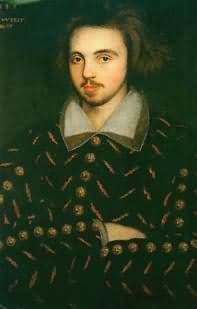
He grew up in Canterbury
and went to school in Cambridge, where it is said he started doing secret governmental work. He died very young at the
age of twenty-nine in a brawl at a tavern. For six years he wrote magnificent dramas in which he perfected blank verse (later
used by Shakespeare) and that include
Dr. Faustus, a story used by the German poet Goethe in Faust and also in Gounod’s opera Faust.
Sir Walter Raleigh (1552 - 1618)
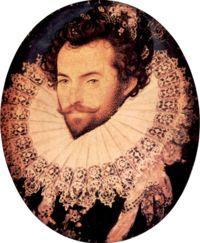
Sir Walter Raleigh was
an English explorer, a favorite of Queen Elizabeth and also a writer. He wrote about his journeys to America, and when he
was imprisoned in the Tower of London for
thirteen years, he wrote a lengthy History of the World. Marlowe and Raleigh wrote a famous pair of lyrics in English Literature
called The Passionate Shepherd to His Love and The Nymph’s Reply to the Shepherd. “The first pastoral pictures
a perfect idyllic love and expresses the Elizabethan ideal of courtship” (PRIESTLEY, 1963), while the second one shows
a very realistic and practical nymph.
Ben Jonson (1572 - 1637)
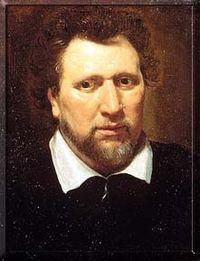
“Next to Shakespeare,
Ben Jonson was the most important dramatist of the Elizabethan era” (PRIESTLEY, 1963). He was the first English dramatist
to publish his plays.
His plays show that he was a distinguished scholar and also his critical opinion about men and their actions. In his poems,
however, he shows appreciation to true beauty and nobility.
Francis Bacon (1561 - 1626)
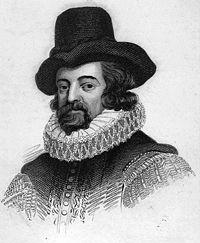
He was not only a man
of letters and science but also a politician. After leaving Cambridge declaring that the educational system failed to challenge
his mind, he turned to travel, private study and law.
When King James I ascended to the throne, he became Lord Chancellor and was titled baron and viscount. Although his success
was fast, he had a lot of political enemies, and for this reason, he was accused of accepting bribes. For that, he was banished
from Parliament, fined and imprisoned. It was the end of his political career, eventually devoting his life to writing and
scientific experiment. He is considered the first essayist in English literature.
References
|
